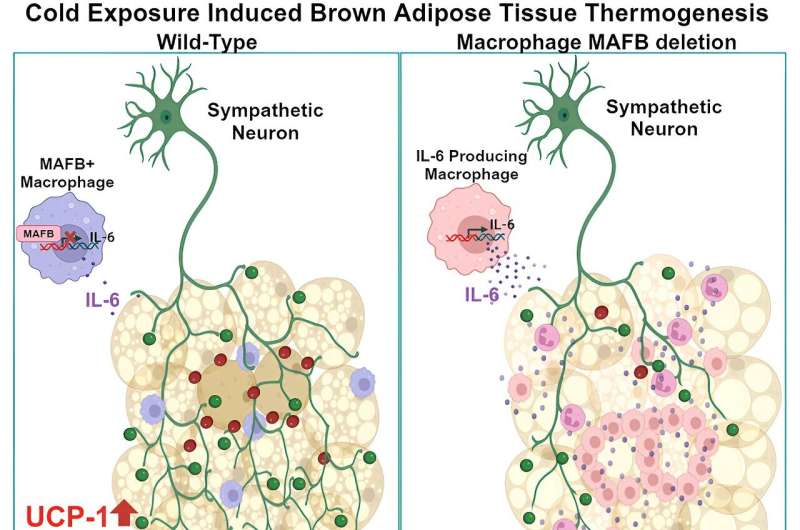This article has been reviewed according to Science X's editorial process and policies. Editors have highlighted the following attributes while ensuring the content's credibility:
fact-checked
peer-reviewed publication
trusted source
proofread
Macrophages produce heat from brown adipose tissue in response to cold, study reveals

Researchers from University of Tsukuba have elucidated the molecular mechanism by which macrophages, a type of immune cell, control heat production in brown adipose tissue to increase the body temperature in response to cold.
Maintaining body temperature in cold environments is critical for survival. However, the detailed mechanisms remain elusive. The body employs two methods for heat production: shivering-mediated heat production by skeletal muscle and non-shivering thermogenesis by brown adipose tissue. The latter is particularly significant for long-term adaptation to cold.
The researchers investigated the role of the transcription factor MAFB in macrophages—an immune cell type involved in non-shivering thermogenesis within brown adipose tissue. This tissue can generate heat to increase the body temperature in response to cold, primarily regulated by the sympathetic nervous system. Therefore, the researchers bred Mafb-deficient mice and exposed them to cold conditions, monitoring their body temperature changes.
Their research is published in the journal Cell Reports.
They found that heat production by brown adipose tissue was reduced in Mafb-deficient mice, leading to a decrease in body temperature.
Additionally, the density of sympathetic nerve fibers in the brown adipose tissue of Mafb-deficient mice was notably lower than that in wild-type mice.
Further analysis revealed that MAFB inhibits the expression of the inflammatory cytokine IL-6, consequently reducing the expression of nerve growth factor in brown adipose tissue and impairing the development of sympathetic nerve fibers.
These results suggest that MAFB-mediated regulation of sympathetic nerve fiber density plays a key role in the thermogenic capacity of brown adipose tissue.
The findings contribute to a novel understanding of how body temperature maintenance is associated with macrophages, with potential implications for health preservation in cold climates and obesity treatment through enhanced energy expenditure.
More information: Manoj Kumar Yadav et al, MAFB in macrophages regulates cold-induced neuronal density in brown adipose tissue, Cell Reports (2024). DOI: 10.1016/j.celrep.2024.113978



















